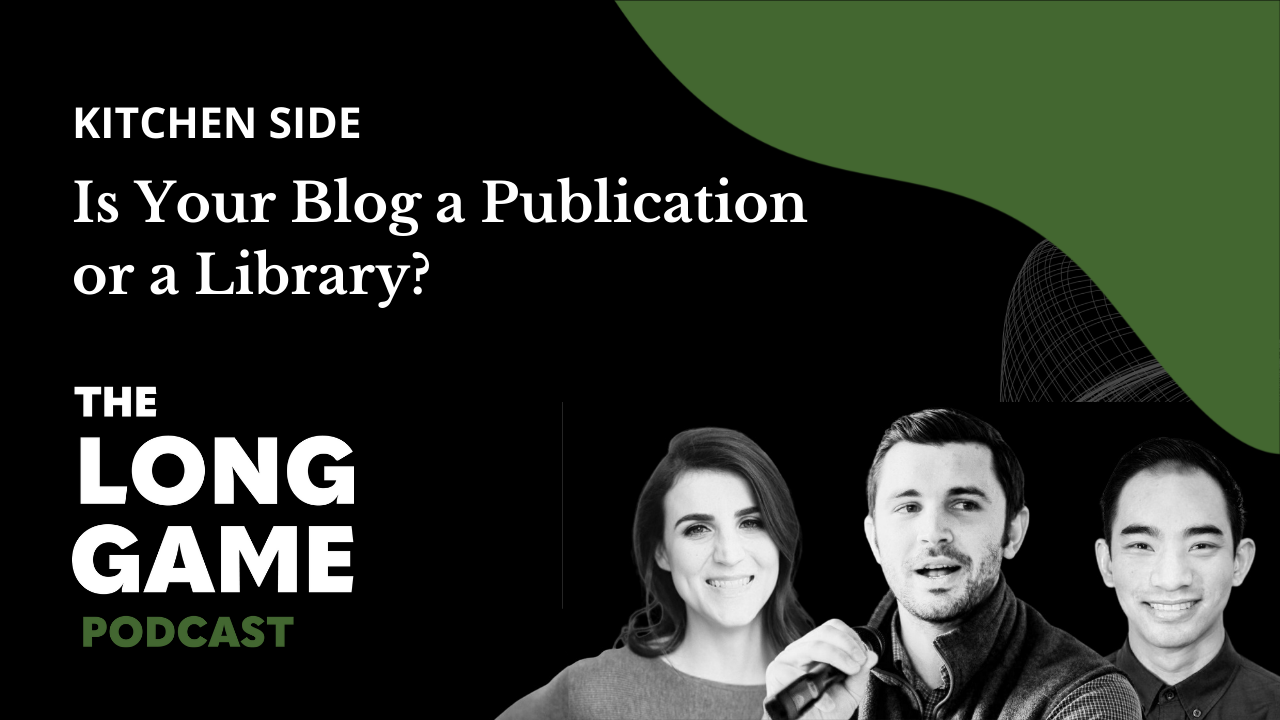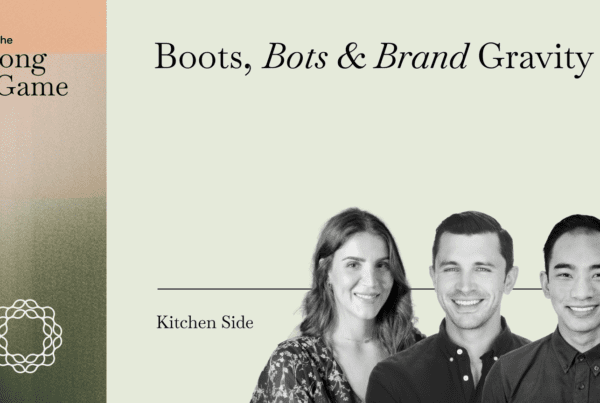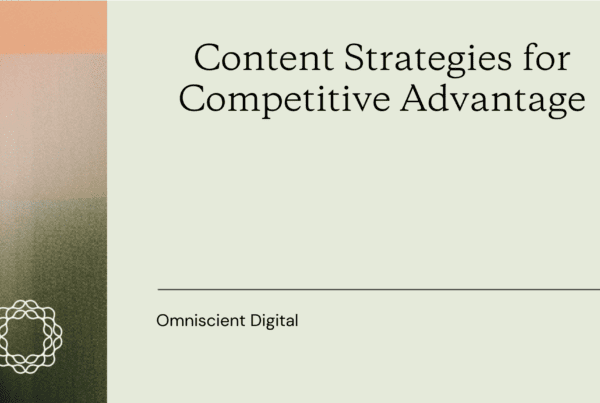
In 2018, Jimmy Daly, then VP of Growth at the content marketing agency Animalz, wrote a compelling post titled Your Blog Is Not a Publication. It outlined why a publication mindset was expensive and problematic, and why “library” style content hubs were superior. In this episode of Kitchen Side, our team explores how we conceptualize this argument in the modern day. Times have changed, and the clear-cut argument that Jimmy made isn’t quite as clear.
Show Topics
- The definition of a library vs. a publication
- Publications create demand, libraries meet demand
- New SaaS companies can stand out with publications
- A hybrid approach to content is best
- Think of your content strategy like a portfolio
What is Kitchen Side?
One big benefit of running an agency or working at one is you get to see the “kitchen side” of many different businesses; their revenue, their operations, their automations, and their culture.
You understand how things look from the inside and how that differs from the outside.
You understand how the sausage is made.
As an agency ourselves, we’re working both on growing our clients’ businesses as well as our own. This podcast is one project, but we also blog, make videos, do sales, and have quite a robust portfolio of automations and hacks to run our business.
We want to take you behind the curtain, to the kitchen side of our business, to witness our brainstorms, discussions, and internal dialogues behind the public works that we ship.
Listen in on this conversation to hear about each host and their backgrounds (Alex Birkett, David Ly Khim, Allie Decker).
Find out what this podcast is about, who it’s for, and how we want to run it.
Listen to the podcast
Watch the video
Key Takeaways
4:20 – The definition of a library vs. a publication
David defined a working definition of a publication as timely updates that are published on a regular schedule. In contrast, a library would be a point-of-reference destination for content.
“A way to simplify, and I’m just speaking off the cuff here, is a publication might be based on reader behavior. A publication is each day, I’m going to check this thing and expect some new content for me to think about. The New York Times is clearly a publication. They might have a library of stuff that you can refer to. But for me personally, I get a newsletter from them every day. That’s a publication. I don’t really care about what happened two weeks ago, such as the news cycle. But for a library, this is stuff I can reference no matter what it is. And it’s just a library of thoughts or a catalog of ideas to go through. A publication is more like every day or habitually; a library is I just need to go here when I need to reference something.”
9:06 – Publications create demand, libraries meet demand
In Allie’s mind, publications serve to share trending information and incite fresh interest. In contrast, a content library would be a more middle-funnel resource for repeat visitors.
“I also think there’s a dichotomy here between establishing demand and meeting demand. I think when it comes to the publication side of things, you’re probably creating demand. You’re sharing maybe original research, you’re sharing a new opinion on a trending topic. Maybe that’s where you, depending on your distribution channel, attract new visitors. And then when it comes to building repeat visitors, that’s when you send them over to your library where you have more evergreen [content]. Maybe it’s a little bit more middle of funnel.”
12:01 – New SaaS companies can stand out with publications
Alex said that an established company like HubSpot can consistently create blog posts that rank. Newer companies can’t necessarily compete on SEO-based pillar pieces.
“Let’s go with HubSpot. They’re going to attack this customer satisfaction angle from all sides. They’ve got a built up website and domain authority that allows them to rank for all that stuff pretty easily, and SEO makes sense as a distribution channel. But if you’re trying to replicate that as a newer SaaS company going up against essentially all these red oceans, there’s not a lot of just clean glean green landscapes anymore in terms of SaaS blogs. You’re going to have to do something to stand out. You can’t just write 2000 words plus 200, and do a skyscraper on all these pieces and expect that strategy to work out. I think you still need some of this I don’t know if it’s timely content, original research, something to stand out, something to build an audience. Otherwise I just think it’s never going to land on that first page of Google.”
12:49 – A hybrid approach to content is best
Allie thinks that a library serves a valuable purpose, but may not work alone as an effective marketing and acquisition lever.
“I think no company is going to set themselves apart through just a library of evergreen content. I think that it can serve a purpose. It can definitely attract traffic from Google if things are optimized. I think it can serve as an asset for sales, customer support, if you need help with the product or the company. But I don’t think you’re ever going to set yourself apart with just, ‘what is X’, ‘why is this important,” ‘X amount of tools to do this.’ And when I think of a library, that’s what I think of. And that has its value. I think that’s why content optimization and updates and refreshes are becoming so prominent, because people have all this awesome content that needs to stay up to date. But that alone as a marketing lever, acquisition lever, whatever, it’s never really going to set yourself apart because so many people are doing it. I think that’s where you have to layer on the publication efforts.”
17:08 – Think of your content strategy like a portfolio
David made the point that a content approach is like an investment portfolio. A certain percent should be allocated to a core library of pieces, rounded out with a percentage of fresh thought leadership and timely topics.
“The context around this blog post was maybe back in 2017 or 2018 when it was written. Lots of websites or blogs were just publishing content on a particular cadence, just for the sake of getting content out there. They’re supposedly a publication. I do remember a trend like that. And now we’ve moved towards a place where everyone tried to do that. It’s great. Now we have all this content, it’s not doing anything for us. And now probably where we’re landing is it’s probably a mix of, you want to publish frequent thoughts and share your ideas, but not just for the sake of publishing content. You should have this core library of content that’s maybe for the goal of demand gen, funnel-based content. And then you have this other content that’s more thought leadership, that’s more timely, and based on whatever the talking points are in that period. And it’s like a portfolio of content that you have to decide hey, how much time are we going to spend on each of these things.”
23:59 – Content should nurture leads
David made the point that content isn’t purely educational; it should gather email addresses and help the sales team close leads.
“I’m going to think about this in terms of a SaaS business. You have a library of content where you want to have evergreen content to capture people through SEO, doing searches for those queries related to your product or business, and you educate them. They want to learn more from you, because they want to get better in the industry. They give you their email. But it’s not just to give them content. It’s to nurture them to eventually buy your product or get your service. And then sure, you might have some of the thought leadership stuff that is a part of your content portfolio that you kind of treat as hey, there’s no distribution channel besides these people who we know are interested in our content. Now we can share these more unique ideas that don’t have an SEO or distribution built into it. I want to open it up too—the library concept doesn’t just apply to prospects or potential customers or existing customers. It’s also for a sales team. How are you enabling them with the library of content on your blog, so that when you’re on sales calls, they can show them hey, this is stuff we actually educate our customers on.”
25:10 – Publications serve to create trust
Allie said that when you start collecting emails from people to send them your publication, you’ve moved from people wanting information to people wanting information from you, specifically.
“Jimmy [Daly] had said: ‘content is built for people who need it when they need it.’ I definitely think the way that Google is designed is to just give people exactly what they need, and that’s it. I think collecting emails is when it switches from someone saying, ‘oh, look, I found my answer’ to, ‘I found my answer, but I’m curious about what else you have to say.’ And then I think that’s a huge trust indicator, or I’m interested in building trust with you, or I like the way you teach me things, I want to learn more from you, especially if it’s a library. HubSpot’s library of information is nothing new. I was one of the writers on that team. I pulled stuff from other blogs. Like it’s literally a way to drive traffic, but the fact that they collect emails even from their most top of funnel pieces, that is how they transitioned from a library to—I don’t want to say to a publication, but to getting that interest from readers. And it becomes less about the information, to more about who’s giving that information.”
26:53 – Zig when others zag
Alex noted that it’s important to do whatever possible to stand out from the crowd. Increasingly, this means compelling publications that are distributed in thoughtful ways.
“When everybody’s doing it, it seems to me that it’s a red ocean and it’s really difficult to compete in. So my inclination in all those situations is to zag when other people are zigging. Ryan [Law] mentioned that Jimmy [Daly] wrote something in his newsletter that was basically walking back and saying, maybe now publications are a thing. And I think we see this trend now with HubSpot buying The Hustle, and other companies I think Stripe and Coinbase and a bunch of these companies are getting into publications and trying to build essentially media arms. It seems like now would be the time to question that advice about the library and say maybe now is the time to stand out in a different way.”
27:57 – Expect a library approach to be a long game
Allie sees building an evergreen library as a valuable pursuit, but one that may not bring in traffic for a long time.
“I think you should build a library. I think you should have low expectations. And I think you should partner with other teams at your company to understand how can this serve more of a purpose than just organic traffic? Because then you don’t have to have these singular traffic goals, because depending on how new your company is, depending on your domain rating, depending on how many resources you have, you might not be able to even make anything of your library for quite a long time. But if you can work with the rest of your team, understand what your sales team needs, you could kill multiple birds with one stone and then maybe get the perks of the organic traffic down the line. So I would say the library is still a great investment, but I would avoid just coming at it from just what our competitors are doing.”
30:35 – Omniscient’s approach to content
Allie described Omniscient’s own situation as one where a content library did not make sense due to their agency’s stage and audience type.
“We evaluated that a library in the sense of pursuing organic traffic from that, wasn’t a good fit for us. Because a), our company is still a baby, it doesn’t have a huge presence in terms of domain rating. So it’s not very competitive on the SERPs. And b), our audience doesn’t need content marketing to be defined. So many of the opportunities that we were identifying, which were at first valid, right? Good volume. Interesting. Our competitors were doing it, et cetera. But then you really thought about like, how does this work in practice? Someone isn’t going to Google ‘content marketing’ and then bam, invest in an agency. There might be a time and place for that down the line. Maybe not that exact query. But it seemed like it was a better use of our resources to lead with our expertise, which in turn ended up being a little bit more timely and trend based content.”
40:24 – Publications allow you to iterate quickly
Alex said the perk of publications is that you can get swift feedback on what resonates with your audience. Libraries will take longer to generate a meaningful feedback loop.
“The cool thing about the publication thing is you can learn a lot faster. You’re going to get pretty rapid feedback on whether something’s working or not. Whereas like the library play, the long form content, the focus on SEO distribution, it’s always going to be a long game. Unless you’re already doing it and you were doing it 10 years ago, like HubSpot, it’s almost always going to take a long ass time to get that feedback loop. So you’ve got to believe in it deeply. And it’s also more expensive too. I think it’s going to be much more expensive to do that play. So it’s one of those things where you have to strategically say, ‘I know we can win here, and here’s how. And I know it’s going to take a long time, but I’ve got faith, and this is going to be the time horizon to try this in.’ So I think there’s different stages of companies where that would work. And if you’re running out of money and you need to raise that next round, maybe the library play’s not going to work in six months. So maybe you’ve got to try something different.”
45:52 – The maturation of a content strategy
David said that most content “portfolios” will evolve and mature over time. Most companies will need to start off with opinion-led publication-style content before transitioning to a more how-to library that can educate a new audience.
“There’s a sort of a maturity model or timeline of company maturity where there’s a sliding scale of your content portfolio. And this gets back to the barbell strategy of a new entrant in a saturated space or creating a new space. You need to have strongly held opinions that will start influencing the conversations in industry and get people to pay attention to your product versus the existing incumbents. And then over time as you build that thought leadership amongst the people who are already thinking about the problems that you solve, over time, that pool of people is going to get smaller and smaller because you’re reaching most of them. You need to start opening up your audience to people who are interested or not as educated on the topic yet, so your portfolio slowly goes from that opinion and thought leadership to more of the evergreen foundational content, building out that library to reach the newbies.”
Connect with Omniscient Digital on social:
Twitter: @beomniscient
Linkedin: Be Omniscient
Listen to more episodes of The Long Game podcast here: https://beomniscient.com/podcast/


